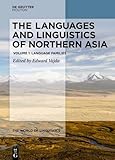The Languages and Linguistics of Northern Asia : Language Families / ed. by Edward Vajda.
Material type: TextSeries: The World of Linguistics [WOL] ; 10.1Publisher: Berlin ; Boston : De Gruyter Mouton, [2024]Copyright date: 2024Description: 1 online resource (XIII, 737 p.)Content type:
TextSeries: The World of Linguistics [WOL] ; 10.1Publisher: Berlin ; Boston : De Gruyter Mouton, [2024]Copyright date: 2024Description: 1 online resource (XIII, 737 p.)Content type: - 9783110554038
- 9783110554069
- 9783110556216
- 409.57
- online - DeGruyter
- Issued also in print.
| Item type | Current library | Call number | URL | Status | Notes | Barcode | |
|---|---|---|---|---|---|---|---|
 eBook
eBook
|
Biblioteca "Angelicum" Pont. Univ. S.Tommaso d'Aquino Nuvola online | online - DeGruyter (Browse shelf(Opens below)) | Online access | Not for loan (Accesso limitato) | Accesso per gli utenti autorizzati / Access for authorized users | (dgr)9783110556216 |
Frontmatter -- Table of contents -- List of Contributors -- Introduction -- I Major language groups of Inner Eurasia -- 1 The Turkic language family -- 2 The Mongolic language family -- 3 The Tungusic language family -- 4 The Samoyed languages -- 5 Khanty dialects -- 6 Mansi dialects -- II Microfamilies of Siberia and Asia’s North Pacific Rim -- 7 The Yukaghir language family -- 8 The Yeniseian language family -- 9 The Amuric language family -- 10 The Ainuic language family -- 11 The Chukotko-Kamchatkan Languages -- 12 The Eskaleut language family
restricted access online access with authorization star
http://purl.org/coar/access_right/c_16ec
The Languages and Linguistics of Northern Asia: A Comprehensive Guide surveys the indigenous languages of Asia’s North Pacific Rim, Siberia, and adjacent portions of Inner Eurasia. It provides in-depth descriptions of every first-order family of this vast area, with special emphasis on family-internal subdivision and dialectal differentiation. Individual chapters trace the origins and expansion of the region’s widespread pastoral-based language groups as well as the microfamilies and isolates spoken by northern Asia’s surviving hunter-gatherers. Separate chapters cover sparsely recorded languages of early Inner Eurasia that defy precise classification and the various pidgins and creoles spread over the region. Other chapters investigate the typology of salient linguistic features of the area, including vowel harmony, noun inflection, verb indexing (also known as agreement), complex morphologies, and the syntax of complex predicates. Issues relating to genealogical ancestry, areal contact and language endangerment receive equal attention. With historical connections both to Eurasia’s pastoral-based empires as well as to ancient population movements into the Americas, the steppes, taiga forests, tundra and coastal fringes of northern Asia offer a complex and fascinating object of linguistic investigation.
Issued also in print.
Mode of access: Internet via World Wide Web.
In English.
Description based on online resource; title from PDF title page (publisher's Web site, viewed 20. Nov 2024)


